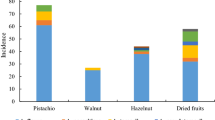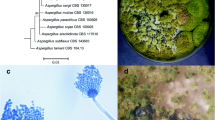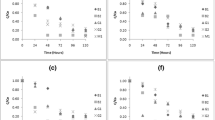Abstract
Some more economical means of producing pure samples of aflatoxin B1 from local materials is described. Our results indicate that there is, however, no correlation between the C/N ratio of the materials investigated and the amount of aflatoxin B1 produced. Pawpaw (Carica papaya) appears the best substrate of those examined in this study.
Similar content being viewed by others
Literature
Adye, J. C. &Mateles, R. I. (1965). Production of aflatoxin in submerged culture;Appl. Microbiol; 13:208–211.
Bassir, O. (1963). Handbook of practical biochemistry; Ibadan: Ibadan University Press, 102 pp.
Bassir, O., Osiyemi, F. O. &Bababunmi, E. A. (1967). Studies onAspergillus flavus (Link) and its metabolites. (1) Production of aflatoxins in cultures ofAspergillus flavus;W. Afr. J. Biol. appl. Chem. 9:31–34.
Davis, N. D. &Diener, U. L. (1967). Growth and aflatoxin production byAspergillus parasiticus from various carbon sources;Appl. Microbiol. 16:158–159.
Davis, N. D., Diener, U. L. &Agnihotri, V. P. (1965). Production of aflatoxins B1 and G1 in a chemically defined medium;Mycopath. Mycol. appl. 31:251–256.
Davis, N. D., Diener, U. L. &Eldrige, D. W. (1966). Production of aflatoxins B1 and G1 byAspergillus flavus in a semi-synthetic medium;Appl. Microbiol. 15:1517–1518.
Dubois, M., Gilles, K. A., Hamilton, J. K., Rebers, P. A. &Smith, F. (1956). Colorimetric method for determination of sugars and related substances;An. chem. 28:350–356.
Jackson, M. L. (1958). Soil Chemical Analysis; London: Constable and Company Ltd., pp. 183–226.
Mateles, R. I. &Adye, J. C. (1965). Production of aflatoxins in submerged culture;Appl. microbiol. 13:208–211.
Parrish, F. W., Wiley, B. J., Simmonds, E. G. &Long, J. Jr. (1965). A survey of some species ofAspergillus andPenicillium for production of aflatoxins and kojic acid; U.S. Army Material Command, Army Natick Laboratories, Technical Report, Microbiology series, No. 2.21 pp.
Steinberg, R. A. (1942). Effect of trace elements on the growth ofAspergillus niger with amino acids; J. agric. Res. Camb. 64:455–475.
Trenholm, R. R. &Ryan, D. E. (1965). Fluorimetric determination of zinc with dibenzothiazolymethane;An. Chim. Acta. 32:317–322.
Visser, S. A. (1967). Studies onAspergillus flavus (Link) and its metabolites: (II) The composition of the mycelium and the influence of various 1% carbon sources on the metabolism of the fungus grown in surface cultures;W. Afr. J. biol. Chem. 2:35–47.
Author information
Authors and Affiliations
Rights and permissions
About this article
Cite this article
Bassir, O., Adekunle, A.A. Production of aflatoxin B1 from defined natural cultures of Aspergillus flavus (link). Mycopathologia et Mycologia Applicata 46, 241–246 (1972). https://doi.org/10.1007/BF02053412
Accepted:
Issue Date:
DOI: https://doi.org/10.1007/BF02053412




